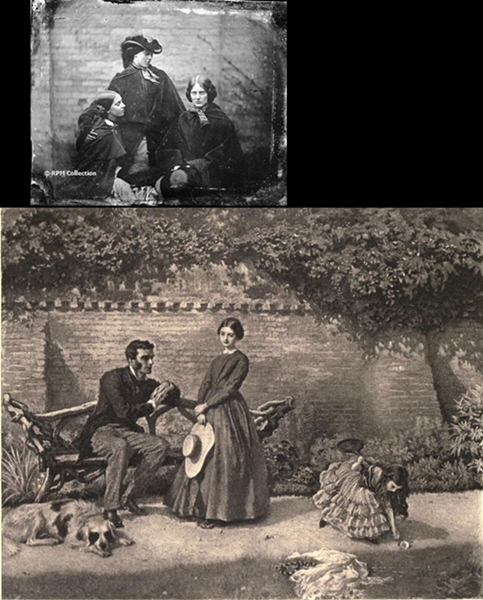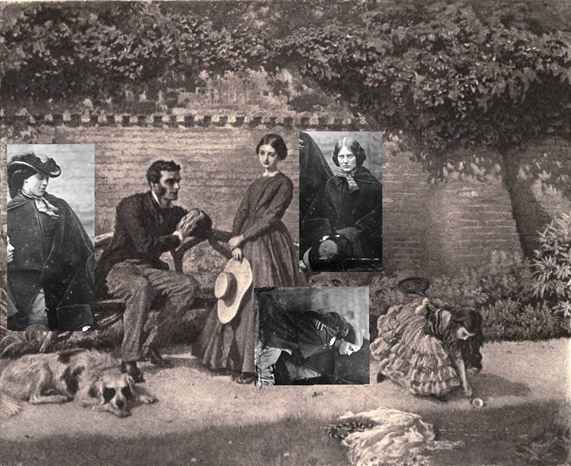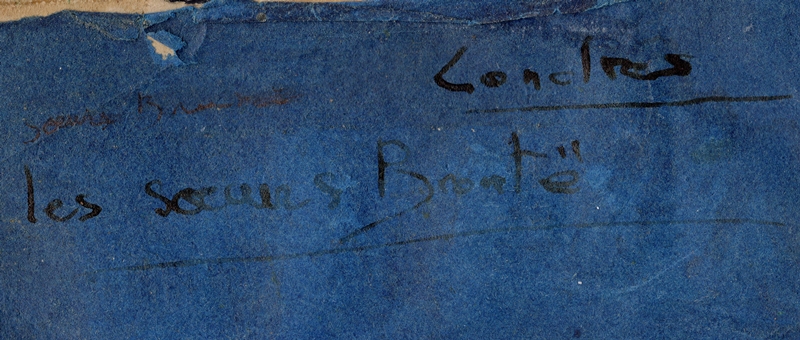| |
Frederick Walker
|
| |
|
Elizabeth Gaskell 's biography of Charlotte Bronte was published by Smith, Elder
& Co., in 1857 with two engravings, one of Charlotte's portrait by George Richmond and one
of Haworth Church & Parsonage. These were the first two images connected with the
Bronte sisters that the general public had seen.
The next Bronte-related image to be created came six years later in the
form of an illustration for Jane Eyre. There are several similarities between the photo, which
dates to about 1857, and the illustration of 1863.
|

|
|
The watercolour has at least three influences; the
novel, a wall in Sutton, Surrey and an earlier attempt by another
artist at an illustration.
The setting is the Garden Scene in the
novel where Rochester is seated but Jane remains standing. The
brick wall in the background still exists in Church Lane,
Beddington, near the artist's home. Jane is probably looking at Pilot the
dog because a copy of an earlier (unpublished) illustration
existed; this was seen by Charlotte in 1853 and the original would have
been at the office of Smith, Elder & Co. The photograph may have been
a fourth influence.
In both the photo and the watercolour the setting is a garden
with a brick wall in the background and two vertical piers or buttresses.
|
|

|
|
In the photograph, Emily is seated sideways on,
looking towards Charlotte (author of Jane Eyre) who is holding a straw hat
and Anne is in profile. In the watercolour, Rochester is
seated sideways on, looking towards Jane Eyre who is holding a straw hat. Like
Anne, Adele is seen in profile but at a 90 degree angle.
|
|

|
|
The heads of the characters in
the painting turned to the same angle as those in the photo. Walker
appears to have created the characters in his painting of 1863 by
transforming the figures in the photograph of c1857. He preferred to paint
from the life but sometimes used photographs.
The three heads in the painting are
similarly positioned. Some details are more evident in the original
watercolour which can be viewed or downloaded on Wikigallery. One example is the shadow cast by Emily's hat
in the photo and the one present in Rochester's profile, even though
the light is coming from a different angle.
|

If the three figures in the watercolour are derived from those seen in the
photograph then it is probable that John Stewart took the photo on glass (the negative) home
to France, where he had the facilities to make a paper print, and sent
it to George Smith in London. This would account for the handwriting “Londres - les
sœurs Brontë” on the reverse.
Stewart may have had hundreds of negatives stored away, presumably
labelled, including the known photos of his daughter, brother-in-law (Sir John Herschel) and
topographical views of Hawkhurst, Kent, but mostly views of the Pyrenees. For most
commercial photographers in the 1850s the finished photograph was on glass and in a
frame with an ornamental metal mat but for John Stewart the photo on glass was just a
negative and the finished photograph was a paper print.
|
|
Illustrating Jane Eyre.
In 1848 Charlotte Bronte was given the opportunity to illustrate her
own novel Jane Eyre but declined. Five years later George Smith sent Charlotte an illustration
for Jane Eyre and she replied:
"The sketch you enclose is indeed a gem; I suppose I may keep it? "Miss
Eyre" is evidently trying to mesmerize "Pilot" by a stare of unique fixity, and I fear I must
add, stolidity. The embodiment of "Mr. Rochester" surpasses anticipation and strikes panegyric
dumb." Letter from Charlotte Bronte to George Smith,
March 26, 1853
This illustration was never used. In 1860 George Smith launched the
Cornhill Magazine with William Thackeray as editor and twelve months later a young artist,
Frederick Walker, began providing some of the illustrations. Two years later Smith and
Walker were on "intimate terms." Walker read Jane Eyre whilst staying with George Smith
at his country residence and suggested illustrating the novel. Smith commissioned him to
illustrate a scene of his choice from it.
The first illustrated edition of Jane Eyre was published in 1872 with artwork by
Edmund Morison Wimperis. Walker's watercolour was exhibited in the 1860s but, at the
suggestion of George Smith, the title was changed from Rochester & Jane Eyre to
The Garden Scene. It does not appear to have been used as an illustration until the
Haworth Edition of Jane Eyre in 1898.
There is a website with many illustrations from Jane Eye: http://janeeyreillustrated.com/Jane_Eyre_faces.htm
|
|
|
Some Useful Links
'Rochester and Jane Eyre' by Frederick Walker
The original watercolour can
be viewed or downloaded at wikigallery.
Frederick Walker and his works
Author: Claude Phillips, Sir.,
Publisher: London, Seeley and Co.; New York, Macmillan and Co.,
Publication date: 1894.
https://archive.org/details/frederickwalkerh00phil_0 (Read online or
free PDF download)
Life and letters of Frederick Walker, A.R.A.,
Author: John George Marks.
Publisher: London, Macmillan and Co./New York, The Macmillan Co.,
Publication date: 1896.
https://archive.org/details/lifelettersoffre00markrich (Read online or
free PDF download)
Frederick Walker
Author: Clementina Black.
Publisher: London, Duckworth & Co.; New York, E.P. Dutton & Co.
Publication date: 1902
https://archive.org/details/frederickwalker00blacrich (Read online or
free PDF download)
The House of Smith Elder
Author: Leonard Huxley.
Publisher: Smith, Elder, and Co., London (Printed for private circulation)
Publication date: 1923
https://archive.org/details/houseofsmithelde00huxluoft (Read online or
free PDF download)
|
|
|

